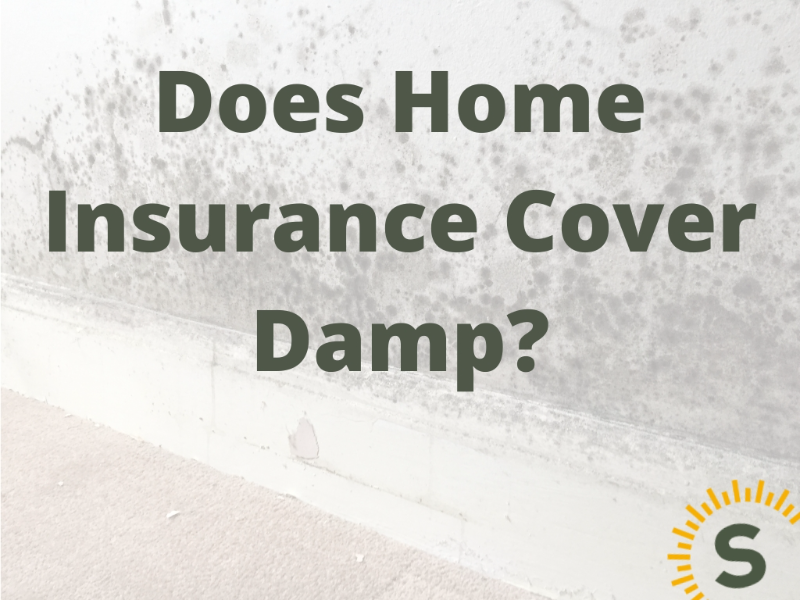
You've noticed some dampness in your house and it's got you flicking through the internet asking, does home insurance cover damp? Well, to answer this question, it's essential to understand the different forms of damp and their causes, along with the specifics of your insurance policy.
This insight aims to guide you through these aspects, providing you with in-depth knowledge and practical solutions.
No, home insurance typically does not cover damp issues as they are considered gradual deterioration and maintenance problems. Exceptions may apply for specific events like storm damage, but in general, damp-related issues fall outside the coverage provided by standard home insurance policies.
Damp isn't covered by home insurance because it's considered a gradual problem that develops over time due to poor maintenance, like not fixing leaks or improving ventilation. Insurance is meant for sudden accidents, not ongoing issues. To deal with damp, homeowners need to take care of their property regularly and fix problems early on.
Damp is a pervasive issue that affects properties regardless of their age. It appears in various forms, the most feared of which is rising damp, often the costliest to fix. There are a few types to look out for:
Rising damp occurs when groundwater infiltrates the walls and floors of a building through capillary action. If the property lacks a damp-proof course (DPC) or if the existing one has been damaged, the water can rise above the foundation level, manifesting as damp patches in the ground-floor rooms.
Penetrating damp is typically caused by water ingress through defects in the building envelope, such as a leaky roof or faulty pipework.
Condensation is the most common form of damp and is caused by excess moisture in the air, which condenses onto cold surfaces when the air cools down.
Rising damp can be identified by the presence of damp patches near the base of internal walls or on floors at ground level. Other signs include rotting skirting boards or floor timbers, peeling paint or wallpaper, stains or tidemarks, crumbling plaster, a musty smell, mould, and powdery salt residues.
Penetrating damp often leads to watermarks on walls and ceilings, damaged plaster, and mould growth.
Condensation is usually visible as water droplets on cold surfaces, such as windows and tiles. It can also lead to black mould growth.
Rising damp primarily occurs due to the absence or failure of a damp-proof course. Additionally, it can be caused by the ground level being raised, inadequate drainage, the use of impervious surface finishes, and the failure of a link between the damp-proof membrane and damp-proof course.
Penetrating damp is typically caused by defects in the building structure, such as a leaky roof, faulty pipework, or cracked walls.
Condensation is primarily caused by poor ventilation, high levels of moisture production within the property, and cold surfaces.
Damp can lead to structural damage, rotting of wood, growth of mould, and decreased property value. Moreover, damp and mouldy conditions can negatively impact health, causing respiratory infections, allergies, and asthma.
Rising damp can be treated with the help of a professional diagnosis. The most common treatment for a damaged or missing damp-proof course involves drilling holes into the affected wall and injecting it with a damp-proof cream which acts as a new course.
Penetrating damp treatment involves identifying and rectifying the source of the water ingress. This could involve repairing the roof, replacing faulty pipework, or fixing cracks in the walls.
Condensation can be managed by improving ventilation, reducing moisture production, and maintaining a consistent indoor temperature.
Damp issues in a house can be expensive to fix, especially if it's rising damp. The extent of work required and specialised materials make rising damp repairs costlier. To get an accurate idea of the cost, you'll need a professional damp survey. The cost mainly depends on your property's size and location.
The primary question - does home insurance cover damp - is typically answered with a 'no'. Most buildings, contents, and landlord insurance policies do not cover gradual deterioration, which is the category that damp problems generally fall into.
There are instances where repairs for damp and water damage may be covered by your building's insurance but these are usually limited to definable events that are beyond the homeowner's control, such as damage caused by a storm.
Most insurance policies will cover you for damage caused by burst, leaking, or frozen pipes. However, leaks caused by accidental damage, such as DIY mistakes, may not be covered.
Claiming for mould on home insurance can be a bit tricky, and it depends on the circumstances and the type of insurance policy you have. In general, most standard home insurance policies do not cover mould damage if it is a result of gradual issues like poor maintenance, long-term water leaks, or high humidity levels.
However, there are some situations where mould damage might be covered:
If the mould growth is a direct result of a covered event, such as a burst pipe, accidental water damage, or storm-related water intrusion, then the resulting mould damage might be covered.
Some insurance companies offer mould coverage as an optional add-on to their policies. If you have purchased this additional coverage, it may help you with mould-related claims.
In some cases, homeowners can add specific endorsements or riders to their policies to cover mould-related issues. These may come with certain limitations and conditions, so it's crucial to read and understand the details of the endorsement.
Certain insurance policies may provide limited coverage for mould, up to a specified amount, even if it's not directly related to a covered event.
In conclusion, it's crucial for homeowners to understand that damp is usually not covered by standard buildings insurance. Preventive maintenance and regular inspections are the best ways to avoid damp-related issues. Always read your policy carefully to understand exactly what is covered and consider seeking professional advice if you're uncertain.

Stuart is an expert in Property, Money, Banking & Finance, having worked in retail and investment banking for 10+ years before founding Sunny Avenue. Stuart has spent his career studying finance. He holds qualifications in financial studies, mortgage advice & practice, banking operations, dealing & financial markets, derivatives, securities & investments.
 No minimum
No minimum  Free Consultations
Free Consultations
 No minimum
No minimum  No obligation consultation
No obligation consultation
 No minimum
No minimum  Free Consultations
Free Consultations
 No minimum
No minimum  No obligation consultation
No obligation consultation
 No minimum
No minimum  No obligation consultation
No obligation consultation
 No minimum
No minimum  Free Consultations
Free Consultations
 No minimum
No minimum  Free Consultations
Free Consultations
 No minimum
No minimum  Coatbridge, Lanarkshire
Coatbridge, Lanarkshire Initial or Ongoing Consultation Fees
Initial or Ongoing Consultation Fees
 No minimum
No minimum  Initial or Ongoing Consultation Fees
Initial or Ongoing Consultation Fees
 £21,000 +
£21,000 +  Initial fee free consultation
Initial fee free consultation
 No minimum
No minimum  No obligation consultation
No obligation consultation
 No minimum
No minimum  Initial fee free consultation
Initial fee free consultation
 No minimum
No minimum  Initial fee free consultation
Initial fee free consultation
 No minimum
No minimum  No obligation consultation
No obligation consultation
 No minimum
No minimum  Initial fee free consultation
Initial fee free consultation
 £101,000+
£101,000+  Bishop's Stortford, Hertfordshire
Bishop's Stortford, Hertfordshire No obligation consultation
No obligation consultation
 No minimum
No minimum  Derry / Londonderry, County Derry / Londonderry
Derry / Londonderry, County Derry / Londonderry Free Consultations
Free Consultations
 No minimum
No minimum  Stockton-on-Tees, County Durham
Stockton-on-Tees, County Durham Free Consultations
Free Consultations
 No minimum
No minimum  Initial fee free consultation
Initial fee free consultation
 No minimum
No minimum  Cheltenham, Gloucestershire
Cheltenham, Gloucestershire No obligation consultation
No obligation consultation
 No minimum
No minimum  Initial fee free consultation
Initial fee free consultation
 No minimum
No minimum  Free Consultations
Free Consultations
 No minimum
No minimum  Initial fee free consultation
Initial fee free consultation
 £51,000+
£51,000+  Sheffield, South Yorkshire
Sheffield, South Yorkshire No obligation consultation
No obligation consultation
 No minimum
No minimum  Free Consultations
Free Consultations





Our website offers information about financial products such as investing, savings, equity release, mortgages, and insurance. None of the information on Sunny Avenue constitutes personal advice. Sunny Avenue does not offer any of these services directly and we only act as a directory service to connect you to the experts. If you require further information to proceed you will need to request advice, for example from the financial advisers listed. If you decide to invest, read the important investment notes provided first, decide how to proceed on your own basis, and remember that investments can go up and down in value, so you could get back less than you put in.
Think carefully before securing debts against your home. A mortgage is a loan secured on your home, which you could lose if you do not keep up your mortgage payments. Check that any mortgage will meet your needs if you want to move or sell your home or you want your family to inherit it. If you are in any doubt, seek independent advice.